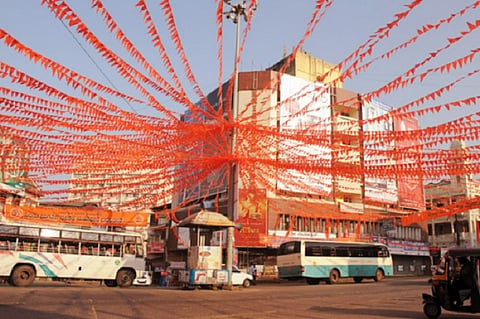'Bunting’ wars of Dakshina Kannada: The string of small flags which fuel communalism
About two weeks ago, I was driving my daughter back from my in-laws’ place at Kulai (Mangalore North), when the six-year-old pointed at few saffron buntings and innocently said that it was 'Hindu' flag. Buntings are strings of small flags, and political parties and groups usually tie them up in streets in the colour which represent them.
Thoroughly shocked, I casually asked her what was our flag. And she instantly replied “Green". It took me quite some time to recover from my daughter's perspective, since we consciously do not speak of politics at home. But I was not surprised.
Since the first communal riots in Dakshina Kannada (Post Babri-Masjid demolition), communalism has penetrated deeply into the lives of the people. After 1992, children being raised in Dakshina Kannada district frequently overhear communal overtones at their homes and elsewhere. Consciously or subconsciously, communalism has influenced every aspect of our lives. So, it is not a surprise when students at anganawadi or primary school these days speak in communal rhetoric.
Across Dakshin Kannada today, it is not rare to find saffron or green flags and buntings flying overhead. Be it a political rally or a religious festival, buntings are the most favoured and cost-effective forms of publicity.
A show of power
Moreover, unlike hoardings and banner advertisements, there are no civic laws in effect to control its use. Both among Muslims or Hindus, boys aged between 15 and 29 years show a lot of enthusiasm and aggressiveness while volunteering to put up flags, hoardings and rolling out buntings for religious, political and communal groups. They think of it as a welcome sign for them to be a larger part of communal or political discourse.
At the height of such zeal, there have been several incidents in Dakshina Kannada, where on the backdrop of bunting, groups with different religious or political affiliations have clashed with one another.
In the recent case of the murder of BJP worker Deepak Rao, the locals told the media that the 28-year old was apparently involved in a skirmish with the local Muslim groups over putting up buntings in Katipalla. Eventually, the squabble allegedly made Deepak a target of communal extremists and he was killed.
Bunting is just not about publicity or promotion of an event, for communal groups it is marking territory and a show of power or dominance in the area. So, for Ganesh Chaturthi, Dasara, Shivarathri - if Hindu groups erect flags or bunting in a particular area, Muslims will try to outdo their Hindu counterparts during Bakrid or Ramzan and vice-versa.
Image courtesy: Lakshmi Prabhala
The bunting is not only limited to the streets or place of their respective worship centres, but the communal groups venture to provoke the other by fluttering such decorations in the area dominated by the other community.
The beginning of buntings culture
While the culture of bunting existed here even earlier, it was more or less limited among the Hindu community, and mostly confined to the temples. That too, earlier the buntings did not comprise of saffron flags, but random colours including red, white, yellow, navy-blue, pink, and green and it was a sign of welcome and celebration – in which all participated.
But then came Hindu Samajotsava in 1998. This was the first time to everyone’s amazements the entire Mangalore city was decked in thousands of meters of saffron bunting. Eventually, saffron took over even in temple observations and eventually to every Hindu observation both private and public. Muslims on the other hand, who were never into such decors, inspired by their Hindu counterparts, also started to float green buntings during their festival and observations.
Following a communal flare-up at Surathkal in 1998 and with over 100 subsequent communal incidents in regions - as chronicled by Human Rights Activist Suresh Bhat, the communal sentiment became embedded as the part of the coastal culture. People may speak of secular outlook, but when it comes to questioning of their own beliefs and faith, they have their own reservations and are defensive.
Today, a person of a particular religion fears to enter the territory which has the bearing or signage of another religion. The insecurity of religious polarization or social ostracism is such that people select their houses or location for business, children’s school or recreation based on whose flag has claimed the territory - the Hindu or Muslim.
The government agencies, along with its security establishments have long seen the bearing that these flag and buntings can have on the psychology of the faceless mob - especially those driven by communal agenda. It can incite, provoke or flare communal unrest, lives and property of several innocents and bystanders maybe lost. However, for the reasons known best to them, the local police (also inclusive of some bent with communal mindset) have stopped short of regulating the use or display of these signages, which though archaic have been an effective tool in the hands of communal propagators in the coastal belt. While there is a standby regulation on public assembly, use of microphones, or bearing of arms, the control on visual provocateurs such as the flags, buntings or banners is by and large overseen or missing.
The author is the President of the State unit of the DYFI and a guest writer for the content provider www.storyinfinity.com (Subs and Scribes Media Ventures).
The opinions expressed in this article are the author's own and do not reflect the view of the TNM or Storyinfinity or their sister concerns or and the advertisers.

